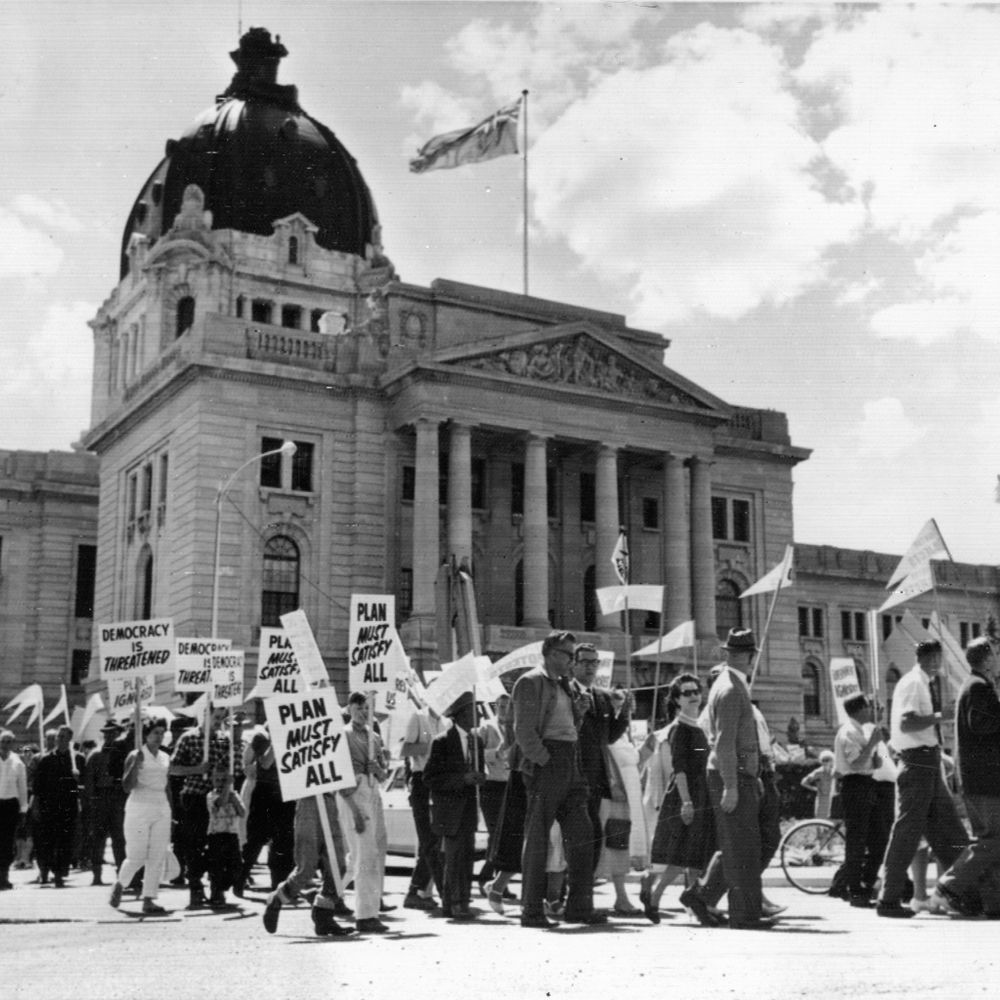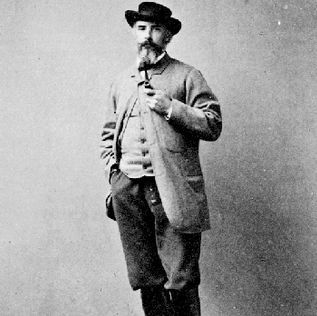
Thank you to Celticmama28 for your donation yesterday! Your support of my work means a lot :)
If you enjoy my Canadian history content, you can support my work with a donation at 👇
www.buymeacoffee.com/craigu
@cdnhistoryehx.bsky.social
Host of the podcast\radio show Canadian History Ehx. Author of "Canada's Main Street: The Epic Story of The Trans-Canada Highway" Sharing Canada's history daily!

Thank you to Celticmama28 for your donation yesterday! Your support of my work means a lot :)
If you enjoy my Canadian history content, you can support my work with a donation at 👇
www.buymeacoffee.com/craigu

In 2026, my hope is to see Canada coast-to-coast with my dog Berton. We will be camping for a few months, and my hope is to turn the trip into a book about Canada and its history.
I've set up a GoFundMe to help fund this project.
gofund.me/0525db538

A vintage black-and-white illustration of a woman with curly hair, wearing a high-necked blouse with puffed sleeves and a belt, sitting and looking thoughtfully to the side, with a window and shadow in the background.
In 1911, Angelina Napolitano killed her abusive husband. While she was sentenced to death, public outcry led to the commuting of her sentence.
Her case brought national awareness to the issue of domestic abuse in Canada.
This is her story.
🧵 1/10

A historic building with a light beige facade, featuring a prominent cylindrical tower with a domed roof, arched windows, and decorative trim. The structure has multiple stories with evenly spaced windows and is adorned with banners reading "Maritime Museum." In front, there are well-maintained green trees, a red kiosk, green bollards, and a street sign reading "Langley." A car is parked on the right side, and a few people are visible near the entrance. The scene is set on a clear day with a blue sky.
The old provincial courthouse in Victoria has a long and dark history.
Many individuals were put to death on the property courtesy of the man known as The Hanging Judge.
Some are still buried there.
This is the story of this haunted location.
🧵 1/9

A black-and-white photograph of a group of people protesting in front of a grand building with a large dome and columns, likely a government or legislative structure. The protesters are holding signs with messages such as "ALTERNATE PLANS IGNORED," "PLAN MUST SATISFY ALL," "SPEND MEDICARE NOW," and "DEMOCRACY IS THREATENED." The scene includes cars and a flag atop the building, with a partly cloudy sky in the background.
In November 1961, the Saskatchewan Medical Care Insurance Bill was given Royal Assent and the province began to implement universal healthcare.
But in May 1962, 90% of the province's doctors went on strike.
This is the story of the Saskatchewan Doctor's Strike.
🧵 1/10
When Hollywood Does Canada: The Devil's Brigade
A fun movie that most historians and veterans feel isn't historically accurate.
The worst thing it did was completely ignoring the most-decorated member of the Devil's Brigade, Tommy Prince.
I would gladly give them a good home and keep them safe
13.10.2025 18:30 — 👍 3 🔁 0 💬 1 📌 0
Sources:
Canadian Encyclopedia: buff.ly/y1ZuujX
Government of Canada: buff.ly/r6HzQIO
Encyclopedia of Saskatchewan: buff.ly/Ya85vmc

I hope you enjoyed that look at the Saskatchewan Doctors Strike.
If you enjoy my Canadian history content, you can support my work with a donation at 👇
www.buymeacoffee.com/craigu
*sources in next post*
🧵 10/10

A black-and-white newspaper article titled "Medicare hardly talked about in campaign" by Val Werier. The article, dated from Winnipeg Tribune, discusses the minimal mention of medicare in the Saskatchewan election campaign. It highlights that despite the passage of the CCF legislation on medicare being a significant issue, it has not been a major topic in the campaign. The text mentions quotes from Liberal Leader Ross Thatcher and CCF leader, noting their stances on medicare and the political strategies involved. The article also includes details about the possibility of buying farms and the Liberals' campaign efforts.
The failure of the strike showed other provinces and the federal government that universal healthcare could work. While the CCF lost the 1964 election, ending two decades of rule, the Liberal government under Ross Thatcher kept Medicare in place.
🧵 9/10

A black-and-white photograph of a group of people marching in a protest, holding signs with messages such as "PLAN IGNORED," "PLAN MUST SATISFY ALL," "DEMOCRACY THREATENED," and "ALTERNATE PLANS IGNORED." The protesters are walking on a road with a backdrop of trees and a partly cloudy sky, suggesting an outdoor demonstration.
Eventually, some doctors returned to work. Lord Taylor, a British physician, was brought in as a mediator. This led to the Saskatoon Agreement that ended the strike on July 23. The agreement allowed doctors to opt out of Medicare and raise fee payments.
🧵 8/10

A black-and-white photograph of a group of people marching in a protest, holding signs with messages such as "PLAN IGNORED," "PLAN MUST SATISFY ALL," "DEMOCRACY THREATENED," and "ALTERNATE PLANS IGNORED." The protesters are walking on a road with a backdrop of trees and a partly cloudy sky, suggesting an outdoor demonstration.
The provincial government brought in doctors from other provinces, Britain and the United States. This allowed community clinics to be set up.
On July 11, 4,000 people showed up to a pro-doctor rally, only 10% of what was expected at the rally.
🧵 7/10

A beige notice addressed "TO OUR PATIENTS" stating that the office will be closed after July 1st, 1962. The text indicates that the practice does not intend to carry on under the Saskatchewan Medical Care Insurance Act.
On July 1, 1962, 90% of the doctors in the province shut their doors. Anonymous letters from a group called The Swift Current Citizens Safety Committee, threatened doctors and their families with violence if they did not return to work by July 6.
🧵 6/10

A black-and-white photograph of a woman wearing a large straw hat and glasses, holding a baby dressed in a white outfit. She is participating in a protest, holding a sign that reads "GOVERNMENT Responsible For CHAOS" and another partially visible sign that says "KEEP ESTEVAN." The background shows a crowd of people with additional protest signs and a building with arched windows, suggesting a public demonstration.
Instead of implementing the plan in April 1962, it was moved to July 1962.
In May 1962, the College of Physicians and Surgeons of Saskatchewan passed a resolution that stated its doctors would close their practices if the plan came into place.
🧵 5/10

A black-and-white newspaper clipping with the headline "Future of medical plans not decided." The article discusses the uncertainty surrounding private medical care insurance plans in Saskatoon, mentioning a Friday passage of legislation to provide a province-wide, compulsory government-operated medical care scheme. It quotes J. A. Brown of Regina, manager of Group Medical Services, stating that the future of GMS, now the Saskatoon Medical Care Insurance, remains undecided. The text mentions ongoing discussions and possible alternatives, including private plans and government action, with no final decisions made.
In November 1961, the Saskatchewan Medical Care Insurance Bill received Royal Assent. Douglas was no longer premier, having moved on to lead the federal NDP. The new premier, Woodrow Lloyd, was pressured to withdraw the plan but instead he delayed its implementation.
🧵 4/10

A black-and-white photograph of a large group of people seated in an auditorium, filling rows of chairs. The audience appears to be attending a formal event or meeting, with many individuals dressed in suits. The room has a high ceiling, minimal lighting fixtures, and a stage area at the front where a few people are standing. Some empty chairs are visible in the foreground.
After a commission was created to look at implementing universal healthcare, the Saskatchewan College of Physicians and Surgeons stated that doctors in the province would not cooperate with a compulsory universal healthcare plan. Despite this, things moved forward.
🧵 3/10

A black-and-white photograph of a man in a suit and tie, sitting at a desk and signing a document with a pen. The desk is adorned with leather chairs, bookshelves, and a patterned wall in the background. The document appears to be formal, with ornate text.
In 1959 Saskatchewan Premier Tommy Douglas made a speech where he announced that the province would establish a universal healthcare plan. In the 1960 provincial election, it was the main issue. After his party won, a plan was put in place to make it happen.
🧵 2/10

A black-and-white photograph of a group of people protesting in front of a grand building with a large dome and columns, likely a government or legislative structure. The protesters are holding signs with messages such as "ALTERNATE PLANS IGNORED," "PLAN MUST SATISFY ALL," "SPEND MEDICARE NOW," and "DEMOCRACY IS THREATENED." The scene includes cars and a flag atop the building, with a partly cloudy sky in the background.
In November 1961, the Saskatchewan Medical Care Insurance Bill was given Royal Assent and the province began to implement universal healthcare.
But in May 1962, 90% of the province's doctors went on strike.
This is the story of the Saskatchewan Doctor's Strike.
🧵 1/10

A muscular man in a black-and-white photo, posing with arms raised and hands clawed, wearing a championship belt labeled "Americas" around his waist, with no shirt and dark pants.
On this day in 1926, Wladek Kowalski, better known as Killer Kowalski, was born in Windsor, Ontario. One of the most famous wrestlers of his era, he won several championships in his career. He later established a wrestling school. He died in 2008.
13.10.2025 14:16 — 👍 43 🔁 7 💬 1 📌 1
A person wearing a blue flight suit with "W. Shatner" and "Blue Origin" written on it, standing with hands clasped in front of a plain brown background. The suit features a patch with "NS-18" and a logo.
On this day in 2021, William Shatner took part in the flight of Blue Origin NS-18 and became the oldest person to fly in space at 90 years 205 days. That record has since been surpassed. Shatner described experiencing the overview effect seeing the Earth from space.
13.10.2025 14:09 — 👍 38 🔁 6 💬 0 📌 0
Congratulations to Canadian Peter Howitt on his Nobel Prize in Economics!
13.10.2025 14:04 — 👍 88 🔁 23 💬 2 📌 2
Sources:
BC Provincial Court: buff.ly/01QGCCo
American Courthouses: buff.ly/JeBHwVO
Victoria Buzz: buff.ly/Jn9Zjis

I hope you enjoyed that story of the former provincial courthouse in Victoria, BC.
If you enjoy my Canadian history content, you can support my work with a donation at 👇
www.buymeacoffee.com/craigu
*sources in next post*
🧵 9/9

An indoor museum exhibit featuring a small sailboat with the text "ALBIA B.C." on its side, displayed under a wooden ceiling with track lighting. In the foreground, there is a vintage diving suit with a large helmet and gloves, standing upright next to a wooden barrel with coiled rope. Various other maritime artifacts and informational displays are visible along the walls and in the background.
Some believe that the figure is The Hanging Judge, still roaming the courthouse. Where the gallows once stood, people have reported a suffocating feeling. Disembodied voices are heard in the building, and visitors have reported objects moving in the night.
🧵 8/9

A black-and-white illustration of a large, historic building with a prominent cylindrical tower topped with a domed roof. The building features multiple stories with arched windows, ornate architectural details, and a fenced perimeter. A utility pole with wires stands in front, and the image is framed with an arched border.
Today, tours are still conducted at the building. The courthouse may not be as empty as people think. Some say ghosts from the courthouse days still roam the halls.
A shadowy figure has been seen moving on the main staircase and looking out the windows.
🧵 7/9

A colorful historic building with a light yellow facade and a prominent cylindrical tower topped with a green dome. The structure features arched windows, green trim, and banners, including one reading "Maritime Museum of BC." In front, there are well-maintained round trees, a red kiosk, and a street sign reading "Langley." A few people are walking, and cars are parked along the street. The scene is set on a clear day with a partly cloudy sky.
The building stopped being a courthouse in 1962 and was home to the Maritime Museum of British Columbia for several years until 2015. That year, the museum vacated the building as the courthouse was not up to seismic code standards and upgrades were needed.
🧵 6/9

A black-and-white photograph of a large, historic building with a prominent cylindrical tower topped with a dome. The building features arched windows, ornate architectural details, and multiple stories. Several people are gathered outside the entrance, and a few are walking on the sidewalk. Power lines stretch across the top of the image, and a car is partially visible on the left side.
He earned his Hanging Judge name because he sentenced many people to death. Those individuals were led to the gallows right outside the courthouse. Many were buried on the property and their remains are still there, underneath Bastion Square.
🧵 5/9

A black-and-white illustration of Sir Matthew Begbie, Chief Justice of British Columbia, depicted with a full beard and wearing a formal suit with a vest. The image is framed with text identifying him and his title, along with the location "Ville de Montréal. Gestion de documents et archives" and a signature dated "1875" at the bottom.
That being said, he was also known as The Hanging Judge. Over several decades, he sentenced many Indigenous people to death and he imposed colonial law over First Nations communities with little regard for their traditional way of life.
🧵 4/9

A black-and-white photograph of a man standing with one hand in his pocket and the other holding a pipe. He is wearing a long coat, vest, dark trousers, and high boots, with a hat on his head. The background is plain, and the image has a vintage style.
The presiding judge at the courthouse was Matthew Begbie. He was well-known for travelling throughout the province on horseback to preside over cases. He was the first judge to rule in favour of an Indigenous man over a white man using First Nations testimony.
🧵 3/9

A black-and-white portrait of an older man with a full beard and mustache, wearing a formal suit with a bow tie and vest. The photograph is framed in an oval shape, typical of vintage portrait styles.
The courthouse was designed by Herman Tiedeman, with modifications made by Francis Rattenbury (an interesting individual I'll cover at a later date). Construction began in 1887 and the building was completed in 1889. The building was celebrated for its eclectic style.
🧵 2/9